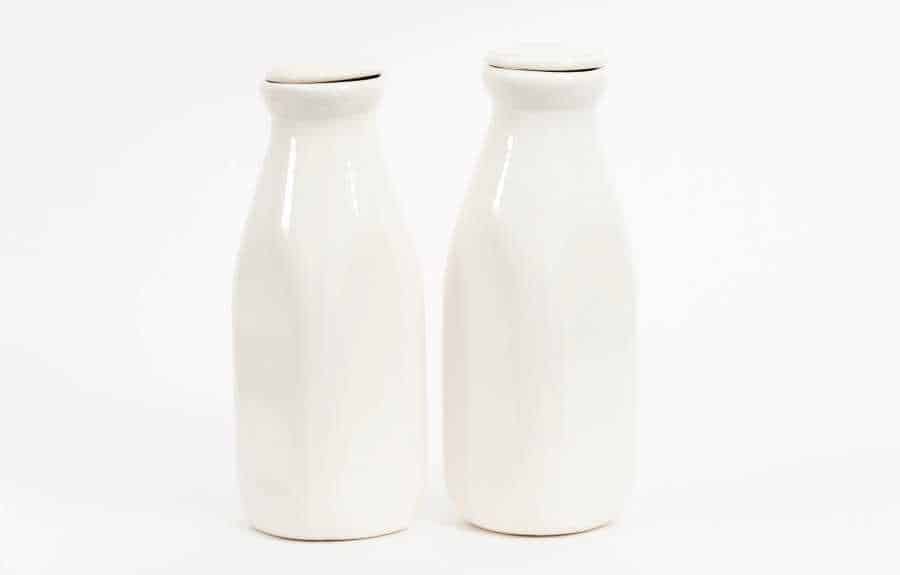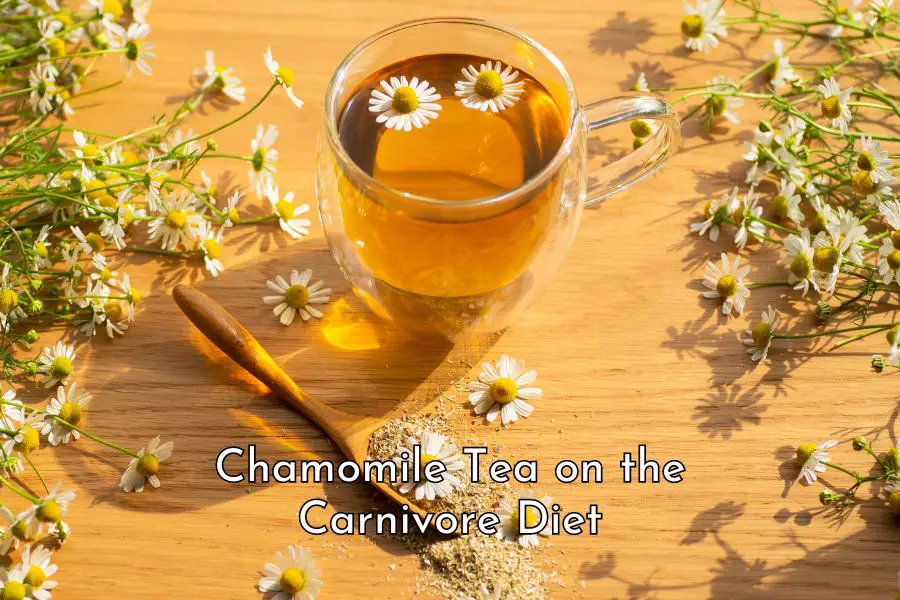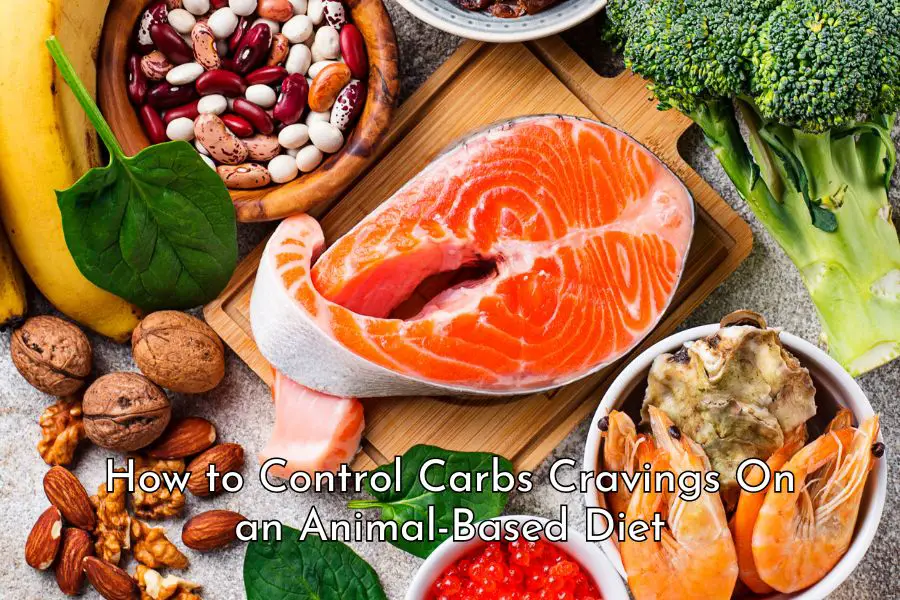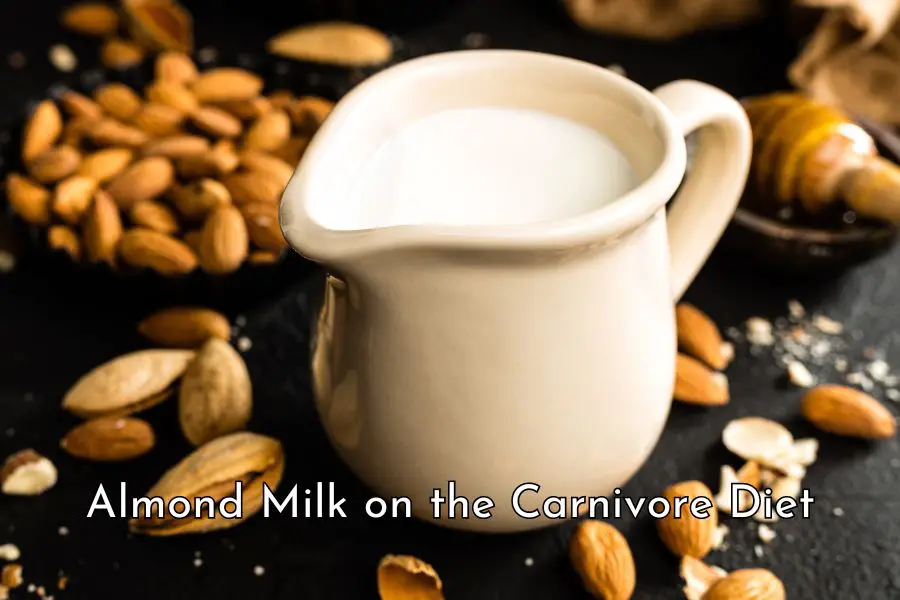A carnivore diet means eating only animal source foods. Milk is an animal source food, but is it healthy? Can you drink milk on the carnivore diet? This in-depth article will review the available evidence and clarify any confusion you may have about milk. However, if you are just after a short answer, here it is:
If you don’t have any specific health issues with dairy, it is perfectly fine to drink milk on the carnivore diet. This is because milk is a complete food that is full of essential nutrients, highly bio-available, free from natural toxins, and has many proven health benefits. Raw milk has even more amazing benefits that are not found in pasteurized milk.
Read on to find out why milk is a healthy food, how to find out if milk is okay for you on the carnivore diet, what kind of milk is best to drink and where to find it, and what kind of milk you definitely should avoid.
Milk referred to in this article is real milk from ruminants like cows, goats, buffaloes, and sheep and excluding drinks labeled ‘milk’ made from plants such as soy, oat, almond, rice, and coconut milk.
Why milk is healthy?
Milk is healthy because it is a complete food that provides complete proteins, good fats, carbohydrates, and essential vitamins and minerals. It is also highly bio-available, free from toxins, and has many proven health benefits. Raw milk, a living food, is even better with many added health benefits not found in pasteurized milk.
1. Milk is full of essential nutrients
Below is the nutrition information of one cup of whole milk containing 3.25% milk fat with added vitamin D according to USDA data.[1, 2]
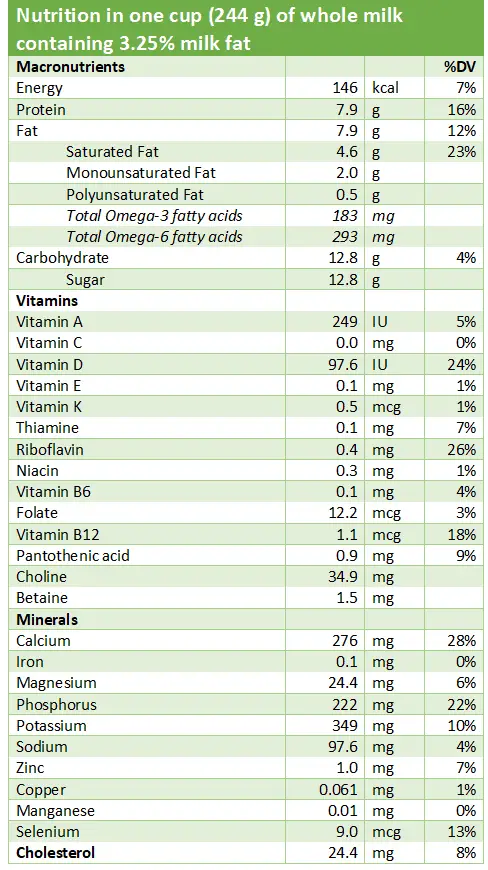
Milk is a complete food that provides all nutrients that an infant mammal ever needs to grow into a healthy young animal and humans are very fortunate to have access to milk.
As can be seen from the table above, milk is a good source of:
- Complete proteins. Unlike plant proteins which are incomplete, milk proteins contain all nine essential amino acids required by humans. There’s also evidence that milk proteins can help reduce the risk of cancer, cardiovascular diseases and improve overall health.[3, 4]
- Good fats. Milk is high in saturated fat which, contrary to dietary advice you may have heard, is not associated with all-cause mortality, cardiovascular disease, and coronary heart disease.[5] It also has a small amount of essential fatty acids, omega 3, which are very important for your health because they are an integral part of cell membranes throughout the body.[6]
- Carbohydrates for energy. As milk is intended for a growing mammal, the natural sugar in milk is a part of a nutritious whole food and a great source of energy.
- Essential vitamins and minerals. It is a great source of riboflavin, vitamins A, and B12, calcium, phosphorous, potassium, magnesium, zinc, and selenium.
2. Milk is highly bio-available
Although you can get all the nutrients in milk from plant foods except for B12, nutrients in milk, intended for a growing animal, are in a highly bio-available form. Nutrients in plants are not as readily available due to the existence of anti-nutrients which we will look at in more detail below.
The table below shows four protein quality rankings of various foods including milk, milk proteins and some plant foods:
- Protein Efficiency Ratio determines protein quality by measuring animal growth
- Biological Value determines protein quality by measuring how efficiently the human body uses dietary protein
- Net Protein Utilization determines the percentage of amino acids consumed that are eventually converted into proteins and utilized by the body
- Protein Digestibility Corrected Amino Acid Score measures protein quality based on human essential amino acid requirements and our ability to digest it.
All protein quality rankings of milk and milk proteins are superior compared to those of plant proteins (eggs are used here as the benchmark). Furthermore, milk and milk proteins all have the perfect digestibility score of one.
| Protein Type | Protein Efficiency Ratio | Biological Value | Net Protein Utilization | Protein Digestibility Corrected Amino Acid Score |
|---|---|---|---|---|
| Eggs | 3.9 | 100 | 94 | 1.00 |
| Milk | 2.5 | 91 | 82 | 1.00 |
| Casein | 2.5 | 77 | 76 | 1.00 |
| Whey protein | 3.2 | 104 | 92 | 1.00 |
| Soy protein | 2.2 | 74 | 61 | 1.00 |
| Peanuts | 1.8 | 0.52 | ||
| Black beans | 0 | 0 | 0.75 | |
| Wheat gluten | 0.8 | 64 | 67 | 0.25 |
| Rice | 2.0 | 64 | 74 | 0.50 |
| Pea | 1.4 | 58 | n/a | 0.59 |
3. Milk is free from toxins
Because real milk is intended for infant mammals, it is free from anti-nutrients or natural toxins. Plant-based milk, on the other hand, is made from plants and contains potentially many kinds of natural toxins that can cause long-term health consequences such as adverse effects on the immune, reproductive or nervous systems, and risk of cancer.[7]
As detailed in this post, plants are stuck to the ground and, to protect themselves from predators, they produce chemicals that are harmful to animals and humans when consumed.
These natural toxins or anti-nutrients are found in their highest concentrations in grains, beans, legumes, and nuts[8] which are often used to manufacture plant-based milk alternatives such as soy, rice, oat, almond, and cashew milk.
For example, if you consume soy milk, a drink that many think of as a healthy plant-based alternative, it’s likely that you are also getting:[9, 10]
- Enzyme inhibitors. Your body produces digestive enzymes to break down foods, but those enzyme inhibitors (trypsin inhibitors, protease Inhibitors, alpha-amylase inhibitors) will do the opposite and interrupt protein, fat, and carbohydrate digestion.
- Isoflavones. They are produced by plants to ward off fungus. In humans, they can cause thyroid problems, inhibit testosterone production and increase estrogen.
- Saponins. Bitter in taste and toxic in high concentration, saponins can affect nutrient absorption and bind with nutrients. They can enter the gut, cause inflammation, leaky gut, and autoimmune issues.
- Herbicides. According to USDA data, around 90% of U.S. soybeans are produced using genetically engineered seeds that are resistant to herbicides such as glyphosate, glufosinate, and dicamba.[11] In simple terms, when farmers spray those “Roundup Ready” soybean plants with herbicides, weeds are killed but the plants would survive. While soybean crops may be resistant to those herbicides, humans aren’t. “In mammals, including humans, glyphosate mainly has cytotoxic and genotoxic effects, causes inflammation, and affects lymphocyte functions and the interactions between microorganisms and the immune system“. [12, 13, 14]
4. Milk has proven health benefits
Based on an assessment of the totality of scientific evidence, Thorning et al (2016)[15] find that milk and dairy products help meet nutrient needs and may protect against the most prevalent chronic diseases. In particular, a diet high in milk and dairy products is associated with:
- reduced risk of childhood obesity
- improvement in body composition and facilitation of weight loss during energy restriction
- a neutral or reduced risk of type 2 diabetes
- reduced risk of cardiovascular disease, particularly stroke
- better bone health in childhood and adolescence
- lower risk of bowel cancer, bladder cancer, gastric cancer, and breast cancer, and not associated with risk of pancreatic cancer, ovarian cancer, or lung cancer.
5. Raw milk is even better for health
Before examining why raw milk is even better for human health, let’s first look at the difference between raw milk and processed milk.
Difference between raw milk and processed milk
The pictures below taken by the Institute for Frontier Science and published by the Raw Milk Institute show the stark difference between raw milk and processed milk.
Raw milk looks alive, just like our own blood, whereas pasteurized milk looked dead with the smooth fined textured matrix. According to Dr. Beverly Rubik PhD, cells are uniformly broken up and lysed by heat, exposing the allergy-triggering internal cell proteins
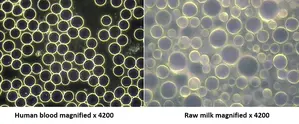

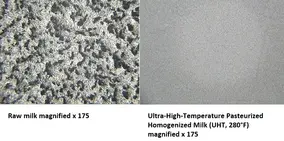
The nutrient profile of milk is also significantly altered by processing. The table below collated by the Australian Raw Milk Movement shows how pasteurization affects the nutrients in raw milk.[16]
| Component | Affect of pasteurization |
|---|---|
| Vitamin C | Raw milk but not pasteurized resolves scurvy |
| Calcium | Longer and denser bones on raw milk |
| Folate | Carrier protein inactivated during pasteurization |
| Vitamin B12 | Binding protein inactivated by pasteurization |
| Vitamin B6 | Animal studies indicate B6 poorly absorbed from pasteurized milk |
| Vitamin A | Beta-lactoglobulin, a heat-sensitive protein in milk, increases intestinal absorption of vitamin A. Heat degrades vitamin A |
| Vitamin D | Present in milk bound to proteins (lactoglobulins); pasteurization halves assimilation |
| Iron | Lactoferrin, which contributes to iron assimilation, destroyed during pasteurization |
| Minerals | Bound to proteins inactivated by pasteurization. Lactobacilli, destroyed by pasteurization, enhance mineral absorption |
Health benefits of raw milk
Raw milk has many amazing health benefits that are not found in pasteurized milk. British Columbia Herdshare Association’s website has an extensive list of studies on raw milk that you can read here. A summary of the findings of these studies done by the association is reproduced below:
- Large multi-country cross-sectional and cohort studies find a protective effect of raw farm milk consumption in childhood against the development of asthma and allergic diseases.
- Cross-sectional studies find a significant protective effect of raw farm milk consumption against rhinitis, respiratory tract infection, otitis, and fever.
- Consumption of raw farm milk is a major independent factor in the “farm effect” by which children exposed to farm environments have a lower incidence of asthma and allergic diseases than non-exposed children.
- Protective effect against asthma and allergy is most pronounced when exposure to raw farm milk begins in utero, followed by consumption prior to one year of age.
- Children fed boiled farm milk are more likely than controls to show signs of milk allergy at age 1, while consumption of raw farm milk is protective against developing milk allergy.
- Childhood consumption of raw farm milk correlates with higher pulmonary function and lower incidence of allergic diseases in adults.
- Many cellular signaling pathways are activated by the consumption of raw farm milk, notably the promotion of regulatory T cell maturation and the epigenetic control of gene expression.
- Raw farm milk is a complex substance containing many bioactive components, including whey proteins, transcription factors, immunoglobulins, omega-3 fats, and microRNAs.
- Commercial processing of milk, including pasteurization, homogenization, and centrifugation, denatures bioactive proteins and RNA molecules and alters the bioavailability of fat-soluble components
Raw milk is safe
There are two kinds of raw milk: one meant to be consumed directly from cows to glasses and one that is intended for pasteurization. The first kind of raw milk is generally from pasture-raised cows and subject to management practice to ensure the animals are healthy and the milk is clean. The second kind of raw milk is typically from concentrated animal feeding operations where animal health is often compromised and antibiotics and hormones are often used. [17]
The first kind of raw milk intended to be consumed raw is very safe. Pathogen tests performed by researchers in Canada and Europe on the two kinds of raw milk find that 4% to 33% of samples of raw milk intended for pasteurization contained pathogens. In contrast, zero pathogens were detected from thousands of samples of milk intended for direct human consumption.[18]
Furthermore, raw milk itself is the only food with built-in anti-pathogen mechanisms that kill pathogens that have contaminated the milk and prevent pathogen absorption across the intestinal wall.[19]
It also has components that strengthen the immune system including lymphocytes, immunoglobulins, antibodies, hormones, and growth factors. [20]
Pasteurization destroys many of these anti-microbial and immune-enhancing components and ultra-pasteurization completely destroys them as shown in the table below. [21]
| Component | Raw Milk | Pasteurized Milk |
|---|---|---|
| B-lymphocytes | Active | Inactivated |
| Macrophages | Active | Inactivated |
| Neutrophils | Active | Inactivated |
| Lymphocytes | Active | Inactivated |
| IgA/IgG Antibodies | Active | Inactivated |
| B12 Binding Protein | Active | Inactivated |
| Bifidus Factor | Active | Inactivated |
| Medium-Chain Fatty Acids | Active | Reduced |
| Fibronectin | Active | Inactivated |
| Gamma-Interferon | Active | Inactivated |
| Lactoferrin | Active | Reduced |
| Lactoperoxidase | Active | Reduced |
| Lysozyme | Active | Reduced |
| Mucin A/Oligosaccharides | Active | Reduced |
| Hormones & Growth Factors | Active | Reduced |
Can you drink milk on the carnivore diet?
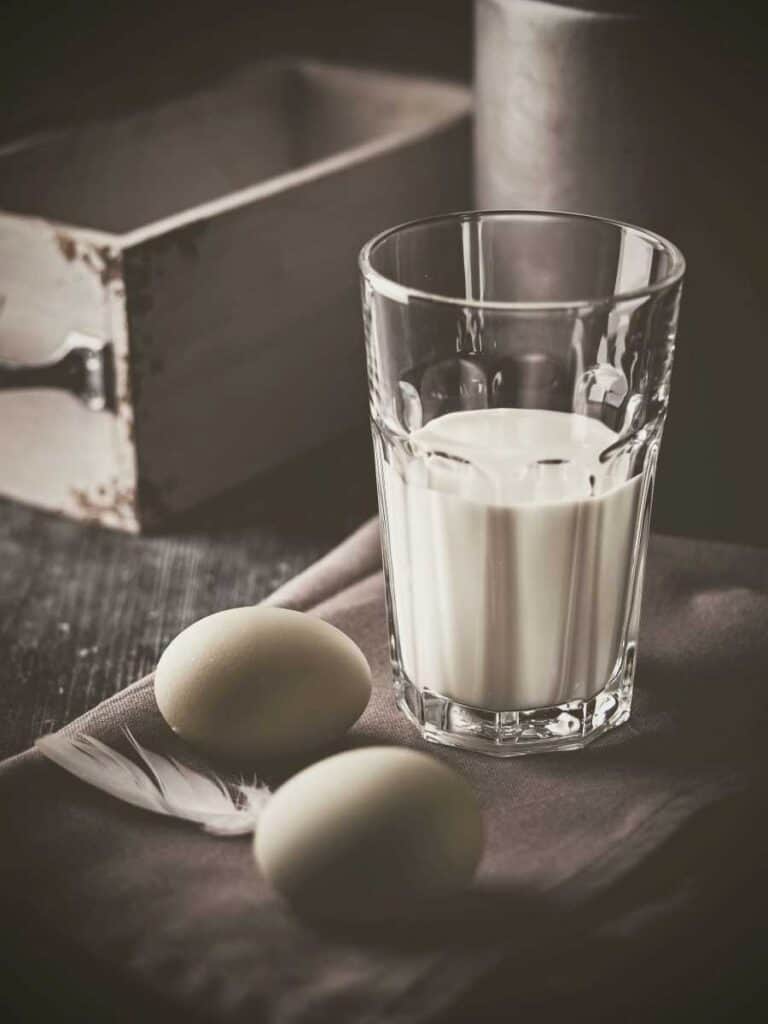
Based on the evidence presented above, it is clear that milk is a healthy and nutrient-dense food. If you don’t have any health issues with milk or dairy products, you certainly can have milk on the carnivore diet as a part of a balanced diet.
Because milk is intended for an infant to grow into an adolescent, it is energy-dense. If you are not a bodybuilder or no longer in a growing phase, it’s probably best to drink it sparingly.
To find out if it is okay for you to drink milk on the carnivore diet, start with full-fat raw milk from pasture-raised animals for a period of time to see how you feel. It could be that you are having problems with milk due to processing (pasteurization and homogenization) rather than milk itself.
But before experimenting with adding milk to your diet, you will have to eliminate all other potentially troublesome foods. That is, you will have to be on an elimination diet first, probably starting with just beef and water, adding other foods gradually and make sure all the foods you currently have are okay.
What kind of milk is the best?
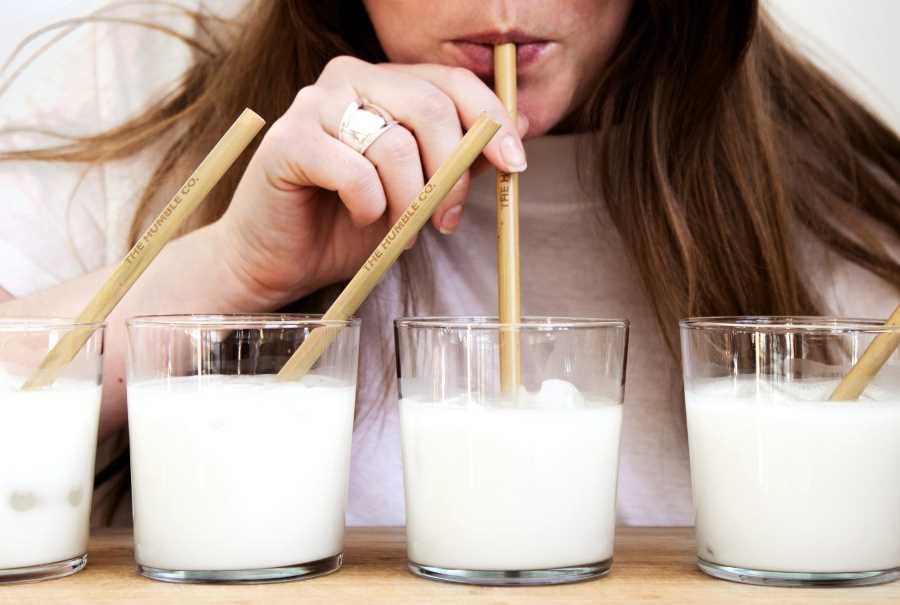
Raw milk is the best
From the above evidence, it is clear that raw milk is the best choice if you can get it from reliable sources.
Where to find raw milk
Raw milk is available in some countries while banned in a few others.
- The U.S. Raw milk is available in retail stores in many states including Arizona, California, Connecticut, Idaho, Maine, Nevada, New Hampshire, New Mexico, Oregon, Pennsylvania, South Carolina, Utah, and Washington. Some states allow farm-to-consumer sales and herdshares too. Here is an interactive map if you would like to find out more about raw milk laws by state. The Raw Milk Institute also has a list of farmers who have been trained in raw milk risk management and optimization.
- Europe. Raw milk is available for sales in many European countries including the UK, Italy, Austria, Croatia, the Czech Republic, Denmark, France, Germany, Greece, Ireland, Lithuania, The Netherlands, Poland, Romania, Serbia, and Slovakia.[22]
- New Zealand. Farmers can sell raw drinking milk directly to consumers either at their farm or by home delivery if meeting government requirements.[23]
- Canada. Raw milk sale is banned.
- Australia. Raw milk sale is banned. However, cold-pressed raw milk, which is produced by applying high isostatic pressure to sealed bottles to destroy harmful bacteria, is available in retail stores. The manufacturer of cold-pressed milk, Made By Cow, claims that their products have a nutritional profile that is almost identical to raw milk.[24]
What kind of milk you should drink if raw milk is not available
The most common types of milk you find in the supermarket are:
- Unhomogenized and pasteurized. This milk is only heated to about 74 degrees for about 15 seconds.
- Homogenized and pasteurized. This milk is heat-treated as above but also processed so that the cream does not separate.
- Long-life milk, homogenized and ultra-heat-treated. Long-life milk is heated to 140°C for two seconds and processed so that cream does not separate.
If you don’t have access to raw milk, it’s best to stick to the least processed milk as possible which is full cream, pasteurized but unhomogenized.
What kind of milk you should avoid
It is best to avoid flavored milk like strawberry, chocolate, oat, and almond milk because they usually have added sugar and sometimes artificial flavorings and colorings.
Below is a comparison of nutrients in whole milk vs various flavored milk produced by a lovely family farm in Colorado, Morning Fresh Dairy Farm. The flavored milk has 54% to 154% more sugar and 27% to 60% more calories per cup than whole milk.[25]
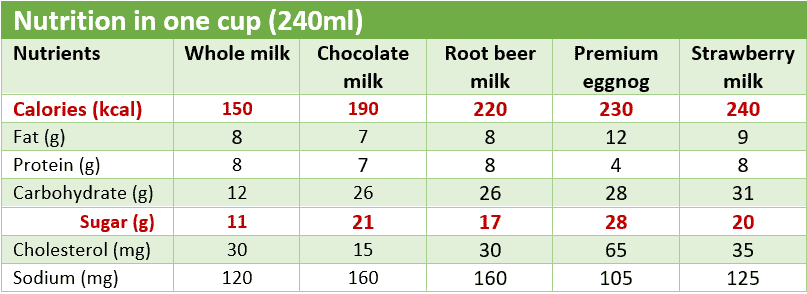
Conclusion
If you don’t have any specific health issues with milk or dairy products in general, you can certainly drink milk on the carnivore diet. This is because milk is a complete food that is full of essential nutrients, highly bio-available, free from natural toxins, and has many proven health benefits.
The best kind of milk to drink is raw milk intended for direct human consumption from farms following management practice that ensures the animals are healthy and the milk is clean.
Disclaimer: The information in this post is for reference purposes only and not intended to constitute or replace professional medical advice. Please consult a qualified medical professional before making any changes to your diet or lifestyle.

